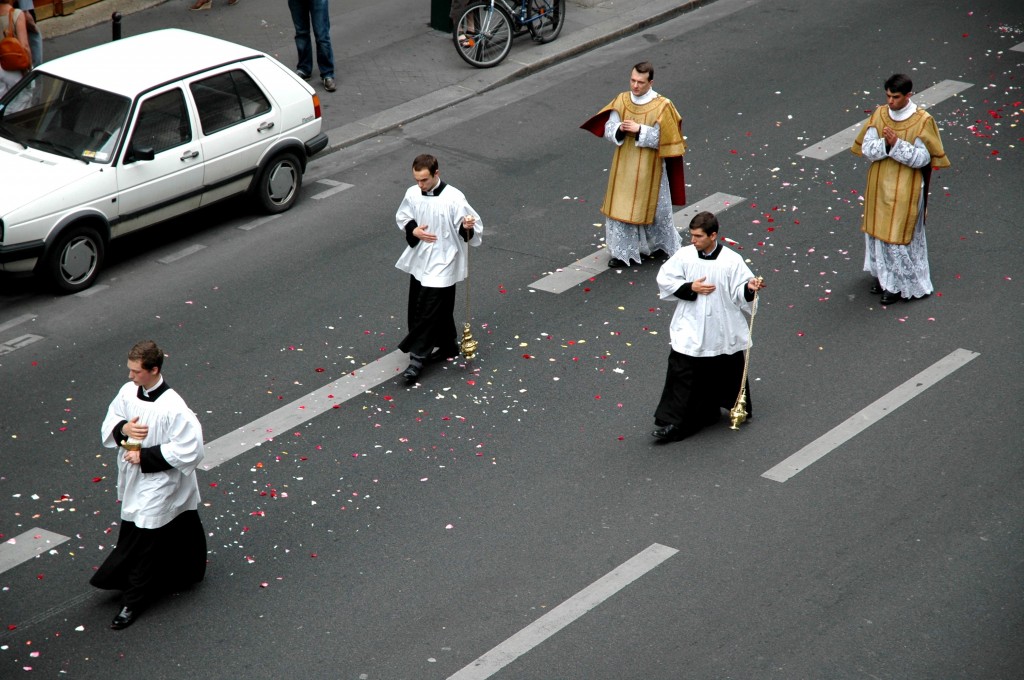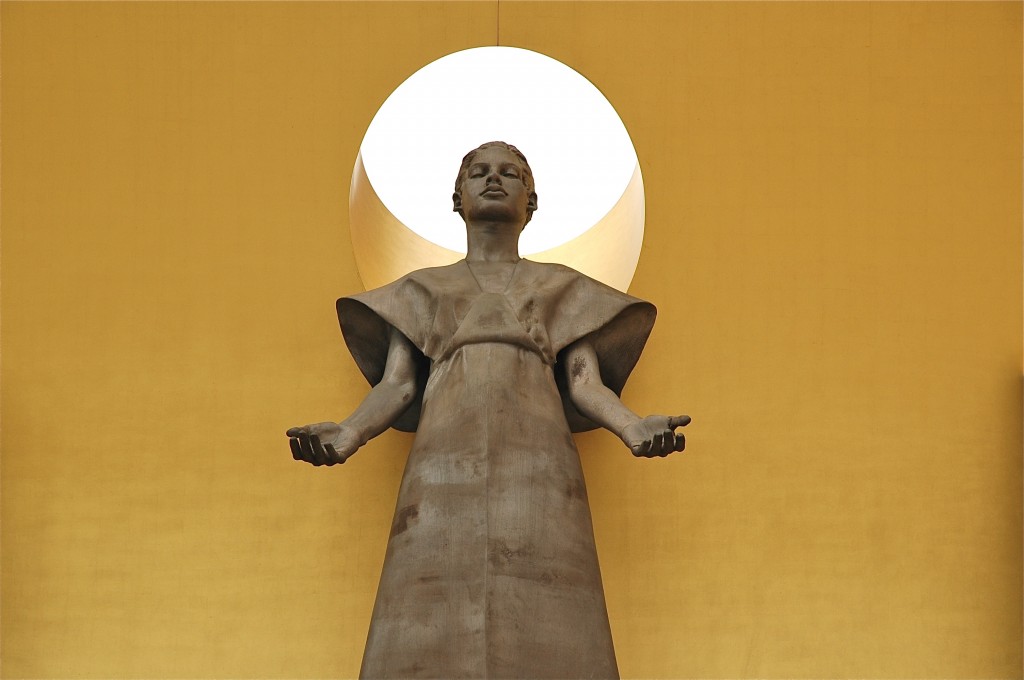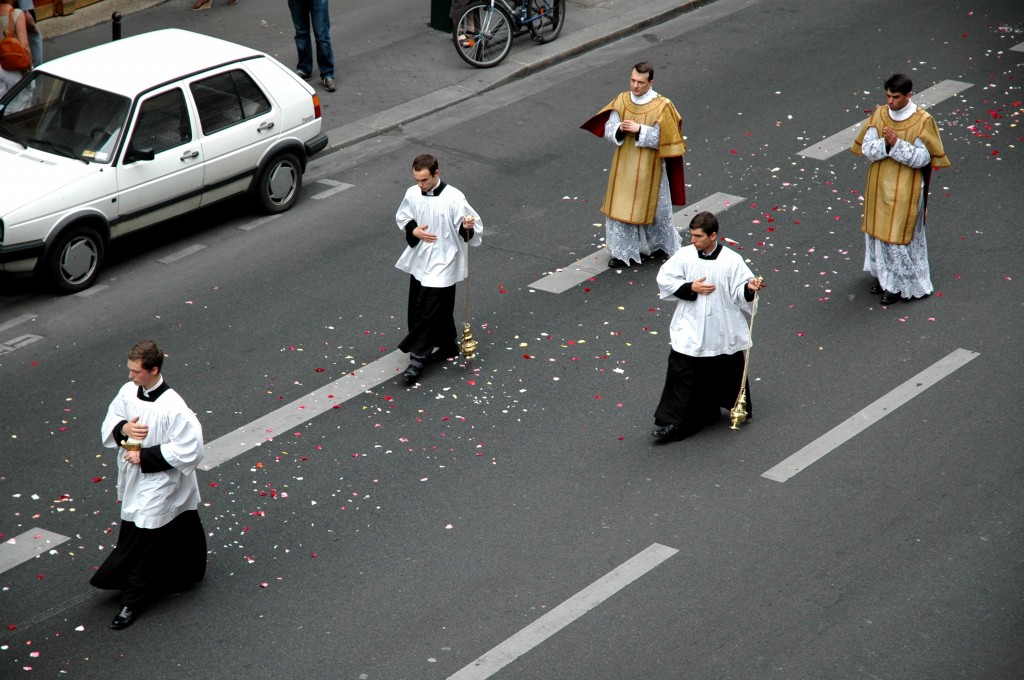By Jim Friedrich
How does the world perceive the church? How do we perceive ourselves? Using six photographs taken over the last ten years, the Rev. Jim Friedrich considers these persistent questions of image and identity.

Corpus Christi procession, Rue des Ecoles, Paris (2005). The antique vestments and gestures appear incongruous or even incomprehensible on a modern boulevard. Like this procession, the church itself appears to many as out of place, a relic of a vanished age. But the very fact of the church’s difference may provide a liberating sign that reality in fact exceeds the assumptions and constructions of secular modernity. In any case, here the church has broken out of its accustomed enclosure into the wider world: a pilgrim people on their way, witnessing to a sacred presence in the precincts of the profane.

The Virgin Mary by Robert Graham, Cathedral of Our Lady of the Angels in Los Angeles (2010). Mary’s outstretched arms and open hands express both receptivity and welcome: a prayerful interiority and an inclusive sociality. Her halo is the sky, but her loving gaze is earthward, upon all who enter the great doors below her. Her face reflects features of many ethnicities. She is neither regal in dress nor aloof in posture: she is one of the people. All these qualities reflect the church’s own vocation to be the face of love for the stranger, the place of shelter for the pilgrim. When I look up at her, I hear her say, “Come inside. You will find rest. You will find God. You are home.”

Altar in Via Negativa, a Lenten worship installation by Jim Friedrich, exploring themes of desert spirituality: absence, privation, emptiness, silence, pilgrimage (2011). To the right of the altar, a torn-up map of the Mojave desert litters the floor. The journey begins by throwing away our maps. Hidden behind the altar, candles illumine a Richard Misrach photograph of grapefruit bushes on fire in a California desert. But this “burning bush” is reached only by a circuitous route, a wilderness wander. William Countryman called the ebb and flow of divine presence “the central rhythm of Anglican spirituality,” and every church, every liturgy, every life knows moments when there is nothing but the waiting and the longing. Sometimes it is we ourselves who are absent before the Mystery, but a reluctance to be located is also a divine attribute. Faith begins at an empty tomb. “He is not here” is part of the Easter message, sending us into the perpetual departures of desert unknowing.

“Graced with Light,” an installation by Anne Patterson at Grace Cathedral, San Francisco (2014). Twenty miles of colored ribbon, echoing the hues of stained glass, fill the emptiness overhead with a visible analog of holy presence: ascending like prayer, descending like grace, hovering like angels. Before the ribbons were hung, the artist invited the congregation to inscribe the upper ends with “dreams, prayers and wishes” so that the space was then continuously filled with the prayers of the people. Christianity is built upon a repertoire of specific stories and symbols, but this wordless, shimmering installation spoke volumes in a Pentecostal transcendence of language. As the cathedral dean noted, “It just lifts people’s spirits.”

Confirmation class at St. Sulpice, Paris, Whitsunday Eve (2011). I happened by the church as the confirmation mass was ending. Afterward the children gathered on the front steps for photos. This image evokes for me the church as a community of storytellers. We all have good news to share. Whatever the girl may in fact be saying, her act of speaking creates a circle around her: community formed by word. Her gesturing hands remind me of Annunciation images, while the two male gazes, one of them directly at the viewer, would be at home in many Renaissance paintings. I also like the way the white albs bestow unity upon this collection of unique personalities. Here is the church as unity in diversity, just like the Holy Trinity.

Youth group members of St. Thomas in Medina, Washington, carry their mission statement to their meeting space (2014). The sign speaks for itself as a rule of life for God’s friends. Even when we fall short of Love’s ideal, we remain committed to carrying its message along as we walk the pilgrim way, and sooner or later it has its way with us.
The Rev. Jim Friedrich is a liturgical innovator, filmmaker, photographer, musician, storyteller, teacher and writer. He is a lifelong Episcopalian: his first church was a movie theater and his second was a stable. He wrote and produced award-winning videos on “The Story of the Episcopal Church” and “The Story of Anglicanism.” He lives on Bainbridge Island, Washington, and blogs as The Religious Imagineer at http://jimfriedrich.com/.

